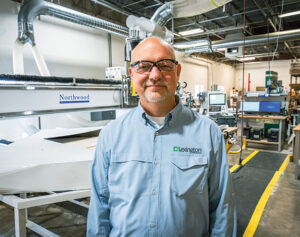Abbey Hellickson is a business growth consultant at Enterprise Minnesota who helps manufacturers engage their workforce, maximize productivity, improve company culture, and strengthen their leadership teams. Drawing on a wealth of experience in talent and leadership development, Abbey enables companies to drive performance at all levels of their organizations and develop the effective leaders they need to build and sustain profitable growth.
Before joining Enterprise Minnesota, Abbey served as the director of business and workforce education at Rochester Community and Technical College and as a corporate training instructor for Fastenal. She has a bachelor’s degree in business administration from Winona State University, and a Master of Education in human resource development from the University of Minnesota.
How do you describe the state of the worker shortage these days? Is it as urgent as it once was?
Abbey: We were definitely seeing worker shortages prior to COVID, but COVID really disrupted our market. We had the challenge of employees who were laid off and then deciding whether to go back. COVID also resulted in a kind of “Great Resignation.” We are still seeing worker shortages, but in the past quarter, it’s starting to ease for some of my clients, depending on their location and the kind of work they do.
As manufacturers continue to face the hiring challenges, there are a few things for them to consider. It is important for them to know who they are as an organization and to make sure they find people who fit. Some companies have felt desperate; they’ll hire anybody. And then those “anybodys” don’t work out. I encourage our clients to take time to vet the applicants to be sure the person fits with the culture. To do that, the company needs to define its values, know what its culture looks like, and know what a good employee is. All of that will provide a good start. It is important to communicate with the team this focus and the reason why: We want our team to know that we are working to hire and we are focusing on bringing in the right people.
We’re reading about “quiet quitting.” What does that mean, and how should manufacturers address it?
Abbey: We have been so focused on hiring that we’ve forgotten how we’re overloading our good people. “Quiet quitting” describes employees who don’t leave a company but they’re starting to burn out; they’re fed up with the extra responsibilities and overtime required of doing more demanding jobs and often without a financial increase. They’re the ones who have to do the extras including the training; if we are churning through new hires, this training element can take a toll. Quiet quitting means that people are less engaged. They’re less likely to go the extra mile; they’re less likely to take on that voluntary overtime.
Mature companies will act to make the difference in how our employees feel. They need authentic and timely recognition. We want to encourage our leaders to have a standard work, a cadence of how they go about their day. All employers spend so much time fighting fires every day that they forget about the people side. I encourage them to carve out time to check in with their teams, to do one-on-ones. The employers who do this are finding good people and keeping them.
Where does automation fit into coping with worker shortages? Do employers pay appropriate attention to the human resource elements of automating their operations?
Abbey: I have a number of clients who are thinking about how automation fits into their work environment. It’s not to replace people. It’s about thinking differently about how to get work done. Many clients are incorporating automation in their facilities, and as they are doing it, they are strategic about which jobs they are looking to automate and the ROI they receive on the investment. There are some situations where automation isn’t a solution yet. I just visited a manufacturer that has some processes that are highly labor intensive. They are a job shop and get a very small amount of custom work, and the end of arm tooling isn’t there yet for automation to become a solution. They know that they will have to deal with the challenges of repetitive work, but what they do instead is rotate it. And so, it’s not like one person had to do one really tedious job all day; instead, they rotate it. Multiple people are cross-trained in this technique, allowing them to work on this repetitive job for short segments.
What do you advise manufacturers to do to retain quality employees?
Abbey: People need to know there’s a pathway for them to grow within the organization, both in terms of skill set and pay. Mature manufacturers who have tackled retention and engagement have created internal development programs that create pathways. So, when employees start, their first experience is positive. They’re given a mentor or a partner who provides the training needed from the start. Employees know there is a way to grow. It helps the company, too. Good development programs will ensure that companies can better endure economic downturns and then come out of them faster.
…
Featured story in the Winter 2022 issue of Enterprise Minnesota magazine.


